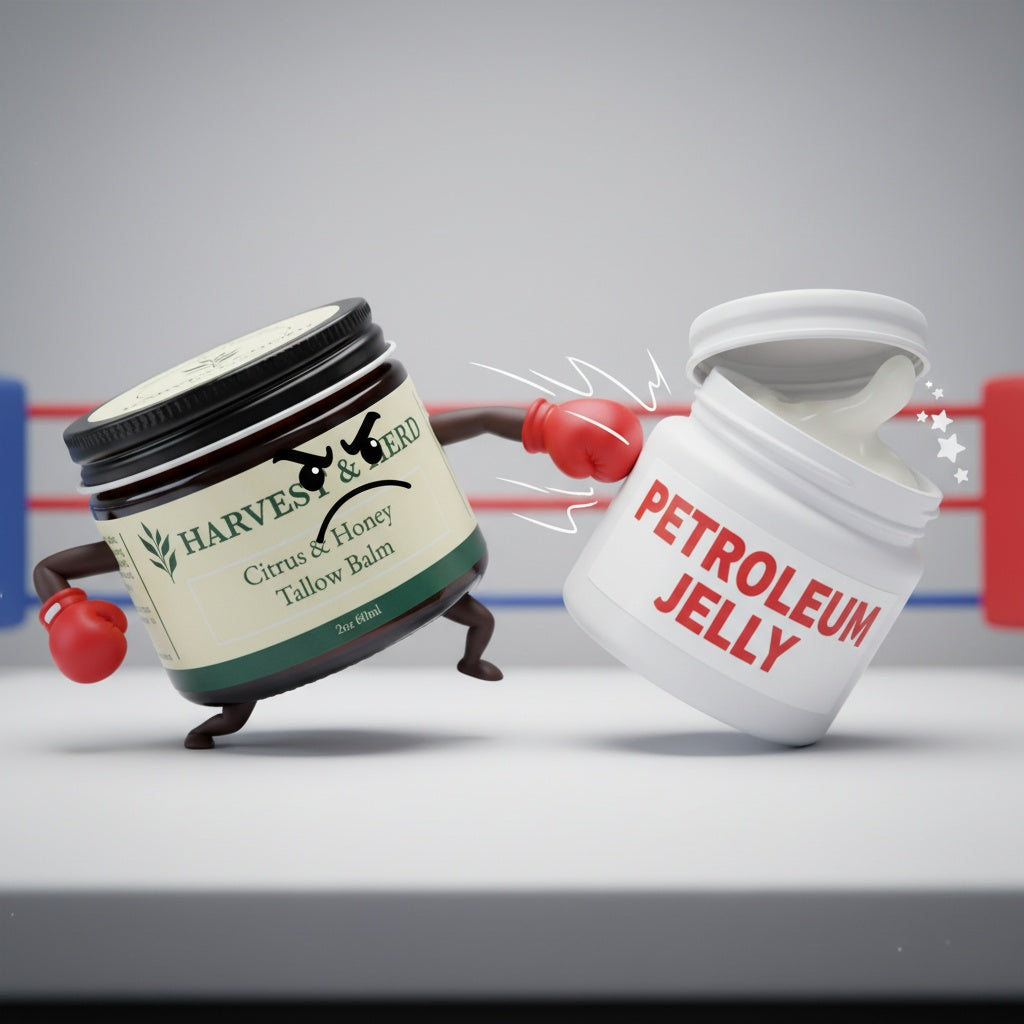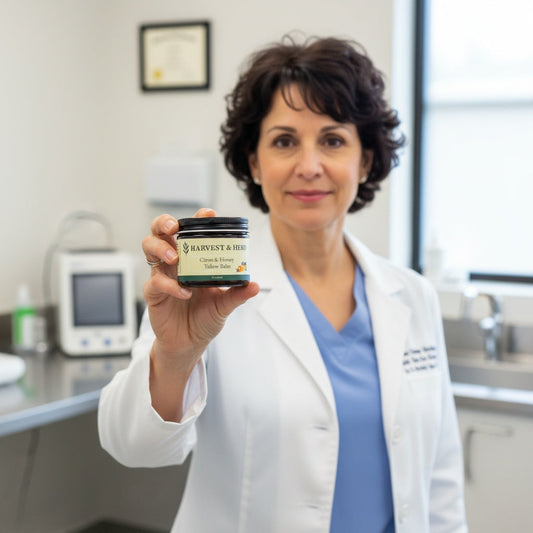
Petroleum-Free Slugging with Tallow Balm
Share
The Problem with Your Current Slugging Routine
You're coating your face in petroleum jelly every night, hoping to trap moisture and wake up with hydrated skin. It works – sort of. But here's what the beauty industry doesn't tell you: that impermeable seal you're creating is essentially suffocating your skin.
Petroleum jelly reduces water loss by up to 98%. Impressive, right? Except it's like wrapping your face in plastic wrap. Everything gets trapped underneath – bacteria, sweat, dead skin cells. Your skin can't breathe, and those expensive serums you applied first? They're not absorbing properly.
We discovered there's a better way. One that's been around for centuries, backed by modern science, and delivers superior results without the drawbacks.
Why Tallow Works Where Petroleum Fails
Here's something that will change how you think about skincare: the Latin word "sebum" – your skin's natural oil – literally means "tallow." This isn't coincidence. It's biochemistry.
Our tallow balm contains approximately 26% palmitic acid, plus significant amounts of oleic, stearic, and linoleic acids. These aren't random ingredients – they're the exact fatty acids your skin produces naturally. When you apply tallow, your skin recognizes it as familiar rather than foreign.1
The Scientific Difference
Recent research from Dr. Russell's 2024 study revealed something the skincare industry should have known decades ago: tallow's fatty acid profile is so similar to human sebum that it integrates seamlessly with your skin's natural barrier.1 Unlike petrolatum, which sits on top creating an artificial seal, tallow works with your skin's existing structure.
- Palmitic acid: Strengthens your moisture barrier by reinforcing the lipid layers between skin cells
- Oleic acid: Increases absorption of beneficial ingredients while maintaining flexibility
- Linoleic acid: Reduces inflammation and supports barrier repair
- Conjugated linoleic acid: Provides antimicrobial protection naturally present in healthy skin2
This isn't marketing speak. It's measurable, documented science that explains why people see dramatic improvements when they switch from petroleum to tallow-based slugging.
How to Master Petroleum-Free Slugging
We've spent years perfecting the application technique. Most people use too much product or apply it incorrectly. Here's the method that delivers professional results:
The Evening Protocol
Step 1: Cleanse Properly
Remove makeup and daily buildup with a gentle cleanser. Your skin should be clean but not stripped – if it feels tight, you've gone too far.
Step 2: Layer Your Actives
Apply your serums and treatments while skin is slightly damp. Hyaluronic acid, niacinamide, retinoids – whatever your routine includes. Give them 60 seconds to absorb.
Step 3: Moisturize
Don't skip this step. Apply your regular moisturizer to create a base layer. The tallow will seal everything in, so you want quality ingredients underneath.
Step 4: Apply Tallow Balm
Here's where precision matters. Take a pea-sized amount – seriously, that's all you need. Warm it between your fingertips until it becomes translucent. Press (don't rub) it gently across your face. You're creating a protective seal, not painting a fence.
The key is achieving the right thickness, too thick and you'll feel greasy. Too thin and you won't get the full occlusive benefit. After a few applications, you'll know the sweet spot by feel.
"After three weeks of replacing petroleum jelly with tallow balm, my skin stopped feeling tight by noon. The flaky patches disappeared. For the first time in years, I woke up with skin that felt comfortable." – Sarah M., verified customer
Who Should (and Shouldn't) Try This
Not every skincare technique works for everyone. We believe in honest recommendations, not universal promises.
Ideal Candidates
- Dry or dehydrated skin: The fatty acid profile specifically targets moisture loss
- Compromised barriers: Eczema, dermatitis, or post-procedure recovery
- Mature skin: Replenishes lipids that naturally decline with age
- Winter-damaged skin: Combats environmental moisture loss
Proceed with Caution
- Active acne: The oleic acid content may exacerbate some types of acne
- Very oily skin: Try spot-treatment on dry areas first
- Known allergies: Always patch test for 24 hours
For acne-prone skin, we recommend "targeted slugging" – applying tallow balm only to specific dry patches, healing spots, or around the eyes and lips. Start with once weekly and adjust based on your skin's response.
The Quality Difference
Most tallow balms disappoint. They smell like beef, feel greasy, or have terrible texture. That's because most brands take shortcuts – whipping air into the formula, masking poor rendering with synthetic fragrances, or using low-quality tallow from grain-fed cattle.
We formulated our Citrus & Honey Tallow Balm differently. No whipping (air bubbles are a texture shortcut). No synthetic fragrances (we use therapeutic-grade essential oils like sweet orange blossom and neroli). Every batch uses grass-fed tallow combined with honey, royal jelly, and a precise blend of botanical oils that enhance rather than mask the natural properties.
The result? A balm that spreads smoothly, absorbs properly, and actually smells pleasant – imagine warm honey with bright citrus notes, not a butcher shop.
Beyond Petroleum: The Bigger Picture
While petroleum jelly comes from fossil fuel extraction, tallow utilizes a byproduct that would otherwise go to waste. But we don't lead with sustainability messaging because that's not why you should choose tallow. You should choose it because it works better.
The environmental benefit is just a bonus – though it's worth noting that recent life-cycle assessments show significantly lower carbon emissions from tallow production compared to petroleum refining when integrated into existing agricultural systems.
What the Research Tells Us (And What It Doesn't)
The science supporting tallow's biocompatibility is robust. Multiple peer-reviewed studies confirm its fatty acid similarity to human sebum and its effectiveness for barrier repair.1,2 However, we need to be honest: direct clinical trials comparing tallow to petroleum in controlled cosmetic applications are still limited.
What we have is compelling compositional data, centuries of successful use, and growing clinical interest in biocompatible alternatives to petroleum. The research gap isn't about whether tallow works – it's about quantifying exactly how much better it works in specific applications.
Your Next Steps
If you're tired of petroleum's drawbacks but want slugging's benefits, tallow balm offers a scientifically-sound alternative. Start with 2-3 nights per week. Use less product than you think you need. Pay attention to how your skin responds.
Most people notice improvements within the first week – better morning hydration, reduced tightness, smoother texture. By week three, the transformation becomes obvious.
Sometimes the most advanced skincare solution isn't found in a lab. It's found in understanding what your skin actually needs and providing it through time-tested, natural compatibility. Your great-grandmother might not have understood fatty acid profiles, but she knew healthy skin when she saw it.
Ready to experience the difference? Our Citrus & Honey Tallow Balm is formulated specifically for modern slugging techniques – no compromises, no shortcuts, just results.
References
1 Russell, M. F., Sandhu, M., Vail, M., Haran, C., Batool, U., & Leo, J. (2024). Tallow, Rendered Animal Fat, and Its Biocompatibility With Skin: A Scoping Review. Cureus, 16(5), e60981.
2 Yang, M., Zhou, M., & Song, L. (2020). A review of fatty acids influencing skin condition. Journal of Cosmetic Dermatology, 19(12), 3199-3204.



